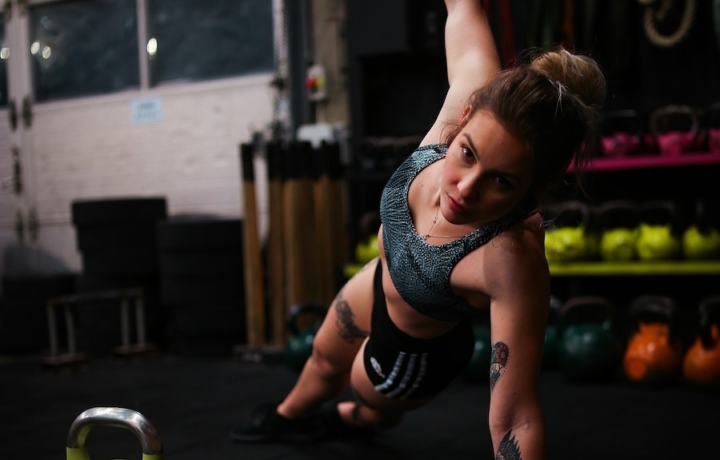Exercise
Reverse Crunch

Reverse Crunch
How to Perform
- Lie on your back with legs bent at a 90-degree angle and your feet lifted off the ground, placing your arms alongside your body with palms facing down for stability.
- Engage your core muscles by drawing your navel toward your spine and slightly tucking your pelvis to eliminate any gap between your lower back and the floor.
- Inhale as you prepare for the movement, maintaining tension in your abdominals and keeping your upper body relaxed against the floor.
- Exhale as you lift your hips off the ground by contracting your lower abdominals, rolling your pelvis upward while keeping your knees at the same angle.
- Continue the movement by lifting your tailbone 2-4 inches off the floor, focusing on using your abdominal muscles rather than momentum.
- Hold the contracted position briefly at the top of the movement, maintaining control and preventing your legs from swinging forward.
- Inhale as you slowly lower your hips back to the starting position in a controlled manner, maintaining core engagement throughout the descent.
- Keep your breathing consistent and your movements deliberate as you repeat the exercise, never allowing your lower back to arch excessively during any phase.
Important information
- Focus on using your lower abdominal muscles to initiate the movement, not your hip flexors or momentum from swinging your legs.
- Keep your shoulders and head pressed into the floor throughout the entire exercise to isolate the core and prevent neck strain.
- If you experience lower back discomfort, reduce your range of motion or place your hands under your lower back for additional support.
- Maintain a consistent breathing pattern, exhaling during the upward phase (contraction) and inhaling during the lowering phase.

Reverse Crunch
Exercise Details
Primary Muscles
Muscle Groups
Mechanic
Built for progress
Take the guesswork out of training
Create personalized AI-powered workout plans that evolve with you. Train smarter, track every rep and keep moving forward, one workout at a time.






The Reverse Crunch stands as one of the most effective core-targeting exercises, particularly focusing on the lower portion of the abdominals that many traditional movements neglect. This intermediate-level exercise has gained popularity in both bodybuilding circuits and HIIT workouts for its ability to effectively engage the entire abdominal wall while minimizing neck and back strain.
Unlike standard crunches where your upper body does most of the work, the Reverse Crunch flips the script by keeping your upper body stationary while your lower body becomes the moving component. This shift creates significant tension throughout your core musculature, particularly in the lower rectus abdominis and the deep transverse abdominis. The beauty of this exercise lies in its simplicity and efficiency – you're getting maximum core activation with minimal equipment requirements.
What makes the Reverse Crunch particularly valuable is its functional carryover to everyday movements and athletic performance. By strengthening the lower abdominal region, you're building a foundation that supports proper pelvic positioning and lower back health. Many fitness enthusiasts find this movement particularly challenging because it eliminates the ability to compensate with other muscle groups – your core must do the work or the movement simply doesn't happen.
For those serious about bodybuilding, the Reverse Crunch helps develop that coveted six-pack definition, especially in the lower abdominal region that often proves stubborn. When incorporated into HIIT protocols, this exercise elevates heart rate while simultaneously building core strength, offering excellent time efficiency. The progressive nature of the Reverse Crunch also makes it adaptable – as your core strength improves, you can increase the challenge through tempo manipulation and range of motion adjustments.
Remember that core training goes beyond aesthetics – a strong midsection forms the foundation of virtually all movement patterns and protects your spine through life's daily activities. The Reverse Crunch deserves a permanent spot in your core training arsenal.
FAQ - Reverse Crunch
The Reverse Crunch primarily targets the lower portion of the rectus abdominis (lower abs) and the deep transverse abdominis. It also engages the hip flexors and obliques as secondary muscles, making it a comprehensive core exercise.
Lie on your back with knees bent at 90 degrees, feet off the floor, and hands either by your sides or supporting your head. Using your lower abs, curl your hips off the floor by bringing your knees toward your chest while keeping your upper body stationary. Slowly lower back to the starting position with control.
The most common mistakes include using momentum instead of core strength, lowering the legs too far (which strains the lower back), and lifting with the arms or shoulders. Focus on controlled movement, maintain proper breathing, and keep your lower back pressed against the floor throughout the exercise.
For an easier version, perform smaller movements with bent knees or use an incline bench for assistance. To increase difficulty, try extending your legs during the movement, adding ankle weights, slowing down the tempo, or performing the exercise on a decline bench to work against greater resistance.
Include Reverse Crunches in your core training 2-3 times per week with at least 24 hours of recovery between sessions. For optimal results, perform 3-4 sets of 10-15 repetitions, focusing on quality movement rather than quantity, and integrate them within a comprehensive core routine for balanced development.







